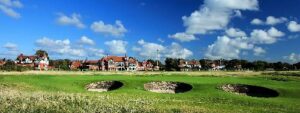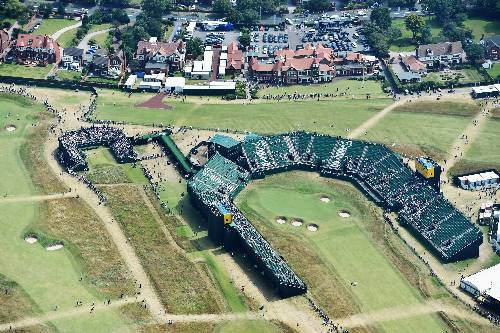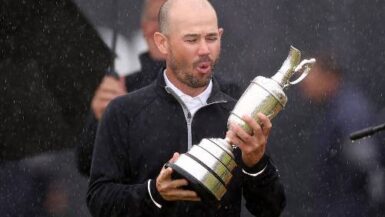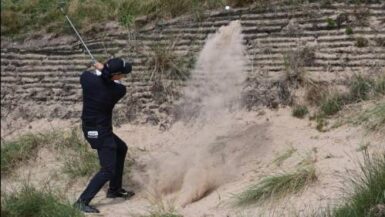
Welcome to the most Jekyll and Hyde of the Open Championship Rota courses, Royal Liverpool Golf Club – Hoylake to its friends.
When one thinks of the town of Liverpool, rock music comes to mind first, of course, not golf. The Beatles put the town on the world map forever and are still the alpha predator of the modern music world. Everyone wants the Beatles as their metaphor, no matter what the milieu. Have you read Golf News Net??!! They’re the Beatles of golf writing!!
But when it comes to golf, Liverpool takes a back seat. Royal Liverpool Golf Club maybe hosting the Open Championship for a 13th time this year, but as far as the design and natural setting of the golf course are concerned, Hoylake won’t win any beauty contests as far as seaside golf courses go., nor top any list of best 100 architectural masterpieces. The Dee Estuary is nowhere near as dramatic as a frothing North Sea or a foamy Firth or Forth. Hoylake not as compelling and dramatic as Turnberry or Royal Portrush, nor as strategic as St. Andrews or St. George’s. It’s not as strong a test of golf as Carnoustie, and given their druthers, most golf fans rather would be gathering at Birkdale or Lytham.
Those towns are more fun for lying by the seaside watching storms roll in.
So why are we here? A combination of history and social indexing. Founded in 1864 and for many decades having the patronage of both the youngest son of Queen Victoria and the present Duke of York, (who played consistently for years to a 7.8 handicap), Hoylake’s contributions to the game are indelible. In 1884, Royal Liverpool started the Amateur Championship, the first golf tournament of its kind in the world. In 1902 when it hosted the Open Championship, Alex Herd won with a rubber-cored ball, ending the dominance of gutta percha golf balls (and the friendship of Allen Robertson and Old Tom Morris at the same time). The precursor to the Walker Cup – a match between English and Scottish amateurs – was contested in 1921, and since its inception over the course of the dozen prior Opens contested over its subtle, yet formidable links, it has crowned such timeless icons as Arnaud Massey, Bobby Jones, Walter Hagen, Peter Thomson, Roberto De Vicenzo, Tiger Woods, and Rory McIlroy.
Moreover, two of the greatest golf writers in the history of either golf or writing – Bernard Darwin and John Hopkins, both of the Times – both of them praise Hoylake for its totality – the whole being greater than the sum of his prodigious parts. First, they celebrate Hoylake’s undeniable penchant for crowning timeless winners – “blown by mighty winds and breeder of timeless champions,” Darwin once wrote. They also praise its membership for its altruism and commitment to preserving golf’s ethos while also creating and conducting the finest tournaments in the game’s long and illustrious history. Put succinctly, Royal Liverpool is foundational in the history of golf. That’s why we’re here.
Since returning to Hoylake in 2006 after a 39-year absence, the R&A has been re-sequencing the holes of the golf course. Play begins on hole number 17, not the first, and then continues sequentially, circling the course in order, finishing play at the 600-yard, par-5 16th. Set in its own alcove adjacent to the clubhouse, the surrounds form a natural amphitheatre with plenty of spectator room while also affording the players a chance at a closing eagle. Still, with OB all along the right, mere feet from the fairway, it is a perilous task; golfers will make anything from eagle to triple. The course will play 35-36 = 71 with a yardage card of 3,495-3,763=7,258.
Unquestionably, the biggest knock to Royal Liverpool’s reputation is its use of internal out-of-bounds not only at the 18th, but at many points across the golf course, adding nuisance to an already narrow golf course. Its other defenses are the 103 tiny, deep, sod-faced bunkers, sheer sinkholes with near vertical faces…basically 103 little ponds.
Scared yet? Try Lytham…there are 210 bunkers like that!

Over the last two Opens, Hoylake surrendered record low scores, but for completely different reasons. In 2006 with no rain for months at a time, the course played biscuit brown, fast and firm. Tiger Woods used nothing longer than 4-iron form the tee all week to avoid the OB and surgically dissected the course with his irons and short game. His game plan became a verb: “He Hoylaked the place,” journalists say.
From Flemma’s Modern Abridged Urban Dictionary: Hoylake (verb, slang) – to club down off the tee to a ludicrous extent, then hit every faireay and shoot 17-under winning in a walkaway. (See also Southern Hills circa 2007.)
Rory McIlroy studied Woods’s Hoylaking carefully, and employed a similar game play in winning the 2014 Open CXhampionship – clubbing down off the tee.
“It’s very, very well bunkered and…that’s I think the biggest challenge of this golf course, avoiding those pot bunkers off the tee,” McIlroy explained in a pre-tournament interview, entering this 151st Open Championship after winning last week’s event, the Scottish Open. “Just getting really comfortable with the clubs you’re hitting off certain tees and whether you challenge the bunkers or not or lay back…you really have to think your way around it.”
The wind finally blew when the Open returned in 2014 but for exactly two sessions – Thursday late, and Friday early, playing right into McIlroy’s hands.
“We got the worst of the weather, and I got really angry when I returned to my hotel room and saw it all cleared by the tie the leaders teed off. McIlroy took advantage and took a four-shot lead into the weekend on his way to winning both the Open Championship and the PGA Championship a month later.
As they say in the UK, “nae rain, nae wind, nae golf.’ Perhaps more than any other Open venue, Hoylake relies on wind as a major defense. Without it, the course is rudimentary, if penal.
“Yesterday was a windy day, but I managed to get out there and play 1 through 5 and then 14 through 18. So, I’ve seen a fair bit of the golf course,” noted defending champion turned LIV golf defector Cameron Smith. “I think it was playing very strong yesterday given the wind…it will be something that we are going to have to deal with all week. Yeah, it’s a very strong test of golf out there.”
So, pour some more strawberries and cream, grab the Beefeater’s Gin, and put the teapot on. It’s the Open Championship, the most exotic golf tournament of the year, and the most historic. And it’s the de facto world championship of golf at one of its most venerable and noble strongholds. Judging from its past, immortality awaits, jut as Royal Liverpool has always delivered.





